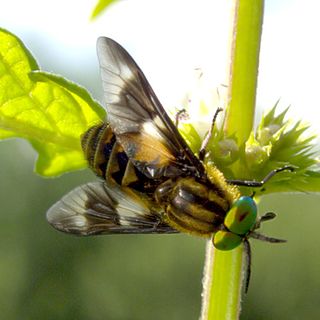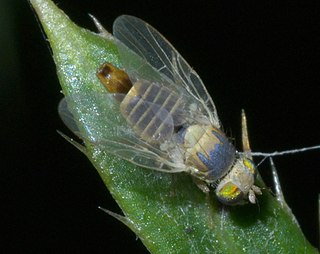
The Tachinidae are a large and variable family of true flies within the insect order Diptera, with more than 8,200 known species and many more to be discovered. Over 1,300 species have been described in North America alone. Insects in this family commonly are called tachinid flies or simply tachinids. As far as is known, they all are protelean parasitoids, or occasionally parasites, of arthropods, usually other insects. The family is known from many habitats in all zoogeographical regions and is especially diverse in South America.

The Ulidiidae or picture-winged flies are a large and diverse cosmopolitan family of flies (Diptera), and as in related families, most species are herbivorous or detritivorous. They are often known as picture-winged flies, along with members of other families in the superfamily Tephritoidea that have patterns of bands or spots on the wings. Some species share with the Tephritidae an unusual elongated posteroapical projection of the anal cell in the wing, but can be differentiated by the smoothly curving subcostal vein. Two species, Tetanops myopaeformis and Euxesta stigmatias, are agricultural pests.

Psychodidae, also called drain flies, sink flies, filter flies, sewer flies, or sewer gnats, is a family of true flies. Some genera have short, hairy bodies and wings, giving them a "furry" moth-like appearance, hence one of their common names, moth flies. Members of the sub-family Phlebotominae, which are hematophagous, may be called sand flies in some countries, although this term is also used for other unrelated flies.
The Nymphomyiidae are a family of tiny (2 mm) slender, delicate flies (Diptera). Larvae are found among aquatic mosses in small, rapid streams in northern regions of the world, including northeastern North America, Japan, the Himalayas, and eastern Russia. Around a dozen extant species are known, with two fossil species found in amber, extending back to the Mid Cretaceous. Under an alternative classification, they are considered the only living representatives of a separate, suborder called Archidiptera which includes several Triassic fossil members. The family has characteristics associated with the Nematocera as well as the Brachycera. The antennae are shortened as in the Brachycera and these flies are long, having a snout with vestigeal mouthparts, non-differentiated abdominal segments with large cerci. The wings are narrow and hair-fringed and have very weak venation. They are known to form cloud-like swarms in summer and the short-lived non-feeding adults have wings that fracture at the base shortly after mating.

The Heleomyzidae is a small family of true flies in the insect order Diptera. Over 740 described species of Heleomyzidae occur in about 76 genera distributed throughout the world.

The Nematoceran family Axymyiidae is the sole member of the infraorder Axymyiomorpha, though it is often included within the infraorder Bibionomorpha in older classifications. It is known from only nine species in four genera, plus eight fossil species.

Clusiidae or "druid flies" is a family of small, thin, yellow to black acalyptrate flies with a characteristic antenna and with the wing usually partially infuscated. They have a cylindrical body. The head is round, the vertical plate reaches the anterior margin of the frons and the vibrissae on the head are large. The costa is interrupted near subcosta and the latter developed throughout length. Larvae are found in the bark of trees, the flies on trunks. The larvae are notable for their ability to jump. Males of many species in the subfamily Clusiodinae have been observed while engaged in lekking behaviour. There are hundreds of species in 14 genera found in all the Ecoregions, although most species occur in tropical regions. The type genus is Clusia Haliday, 1838.
Dilbert Elmo Hardy was an American entomologist who specialized in Diptera systematics.

Superfamily Tabanoidea are insects in the order Diptera.

Corethrellidae are a family of biting midges, small flying insects belonging to the order Diptera, females of which feed on the blood of frogs. The members of the family are sometimes known as frog-biting midges. The family currently consists of just one genus, totalling 115 extant and 10 fossil species worldwide. Most extant species are found in the lower latitudes, usually associated around the tropics.

Campiglossa is a genus of fruit flies in the family Tephritidae. There are at least 190 described species in Campiglossa.
Charles Howard Curran was a Canadian entomologist who specialized in Diptera. Curran's main taxonomic interests were in brachyceran flies, particularly the flower flies Syrphidae, in which he described 723 species. He described 2,648 species over his career. He was active in the study of insect control. His 1934 work The Families and Genera of North American Diptera was an important and comprehensive work on the topic of North American fly genera.

The Milesiini is a large and diverse tribe of hoverflies. They mimic wasps or hornets.
Cornelius Becker Philip (1900–1987) was an American entomologist, noted for assigning comedic names to species he described.

John Merton Aldrich was an American entomologist. Aldrich was the Associate Curator of Insects at the United States National Museum. He is considered one of the most prolific entomologists in the study of flies.

Tachininae is a subfamily of flies in the family Tachinidae.

Tephritini is a tribe of fruit flies in the family Tephritidae. There are about 80 genera and some 1000 described species in Tephritini.
Oreogetonidae is a family of flies. There is at least one genus, Oreogeton, and at least 30 described species in Oreogetonidae.

Terelliini is a tribe of fruit flies in the family Tephritidae. There are at least six genera and about 104 described species in Terelliini.

Mesembrinellidae is a family of Neotropical flies in the order Diptera, and formerly included in the Calliphoridae. There are 36 described species.















